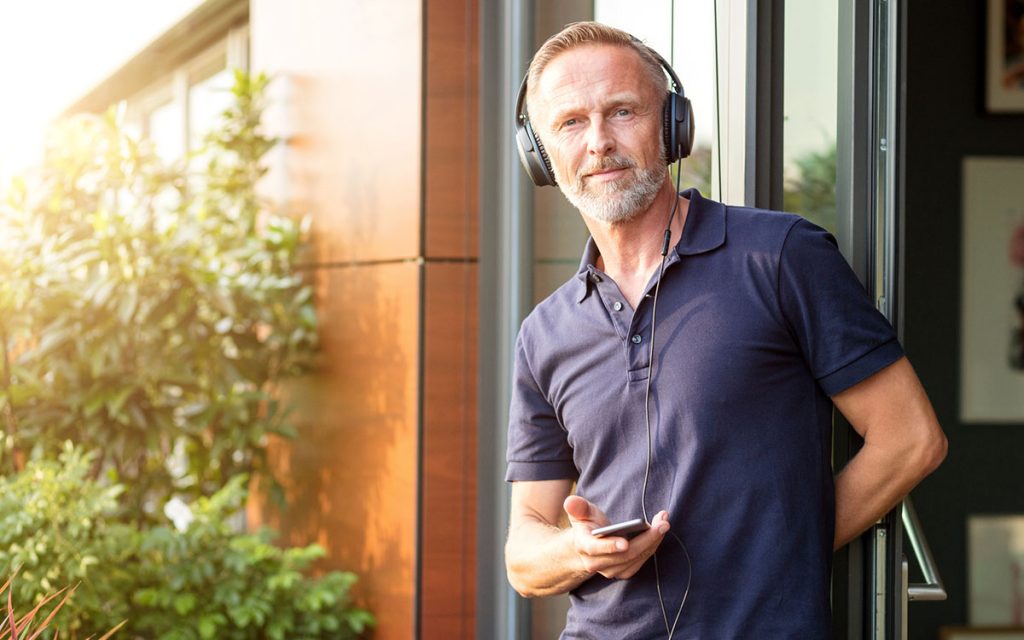Noise-related hearing loss doesn’t only affect people who work in loud environments, like construction workers or heavy metal roadies. Noise is noise – it doesn’t even have to be work-related to cause damage. Leisure-related noise exposure can be damaging, too. The most common kind? Loud sounds heard through headphones, whether it’s music, gaming, streaming video, or even an audiobook with the volume cranked up.
You might not think your smartphone or tablet can get that loud (we’ll just assume you don’t use a Walkman). But these devices can reach sustained volumes of over 105 dB. (To put this an especially scary way, 110 dB is the average human pain threshold—i.e., the volume at which noise starts to literally hurt your ears.) So what can you do to protect against this kind of noise-related hearing loss?
The volume level here is important. An easy shorthand that’s widely recommended is the 60/60 rule: Listen with the volume at no more than 60% for no more than 60 minutes at a stretch (because the length of sound exposure matters, too). What kind of headphones let you do this comfortably may be a matter of personal preference, but there are things you should consider there as well.
Over-the-ear headphones
While the foam-covered earpieces that came with your old Walkman are mostly a thing of the past, over-the-ear headphones have made a comeback. Often surprisingly pricy, they offer lots of color options and celebrity endorsements—and yes, superior sound quality. And unlike those little foam pads, these cover the entire ear, blocking outside noises.
Conventional wisdom is that these are safer than in-ear headphones because the source of the sound is further from your eardrum. But the reality is they’re often capable of much louder sound than their smaller kin—the speakers are much larger. Additionally, noise-canceling may help you ignore the crying baby on your flight, but in other situations, it can block sounds you need to hear (like a car honking). That said because they block out outside noise, you can often lower the volume of what you’re listening to so it’s not loud enough to harm your hearing…so consider how you would be using these to see if they are worth it.
Earbuds
The standard earbuds that come with devices like iPhones are much maligned for their poor sound quality, though many people still use them because, hey, they came with the phone. Plus with newer models that lack a headphone jack, sticking with Apple’s earbuds can just be easier.
The downside—besides the poor sound quality—is that basic earbuds don’t block outside noises, so you’re more likely to pump up the volume. (Even if it’s just to hear the person on the other end of the line!) Again, though it’s often said that earbuds are problematic because you stick them in your ear—so their speakers are extremely close to your eardrum—volume is the biggest issue. Another issue with these is that you can’t wear them with hearing aids.
Occluding or isolating earbuds
Many people choose earbuds with a rounded, rubbery tip both because they’re more comfortable than standard earbuds and better at blocking outside sounds. The rubber molds to the shape of your ear, creating a seal that stops other sounds from getting in. Not to sound like a broken record, but these have the same drawbacks as the other two (it’s all about the volume), as well as carrying the same caution as over-the-ear headphones (they can block out warning sounds). Obviously, these won’t work for you if you have hearing aids.
What headphones should you use?
You may have to test out more than one pair before you find headphones that suit your needs. Depending on what you’re most often using them for—talking on the phone, say, versus listening to music—you’ll have different acoustic expectations. The important thing is to find headphones that make it comfortable for you to listen at a safe volume.
How can you be sure it’s safe? There’s an app for that! You can download the National Institute for Occupational Safety and Health’s free Sound Level Meter app. There are other apps out there, but research has found that the accuracy of these other apps is hit-and-miss (also, for whatever reason, Android-based apps have proven less accurate). That prompted NIOSH to develop their own app. The app lets you measure external sounds, but you can also measure the sound coming from your device’s microphone—in other words, the true volume of what’s being sent to your ears. It’s a little bit of work, but taking these kinds of preventative measures can help protect your hearing.


